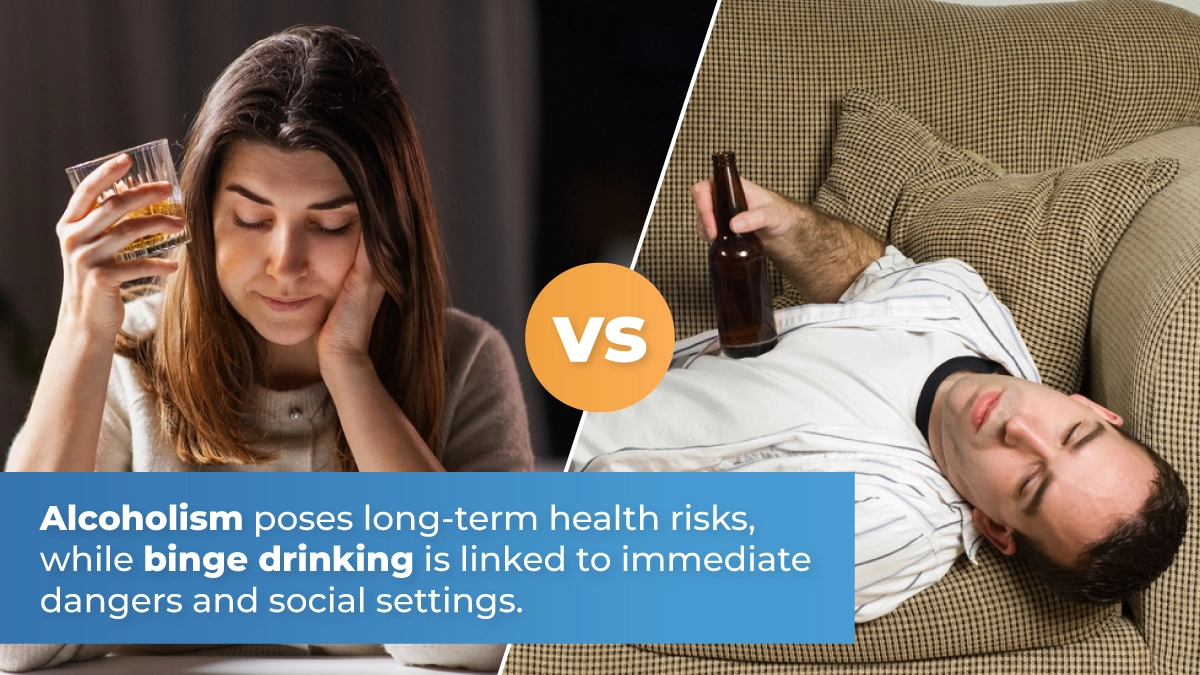Pour Choices: Alcoholism vs. Binge Drinking
Alcoholism and binge drinking are two distinct yet interconnected facets of problematic alcohol consumption. While binge drinking involves episodic, excessive alcohol intake in a short span, alcoholism is a chronic condition characterized by an uncontrollable and compulsive need for alcohol, often leading to dependency.
Both pose serious health risks and societal challenges, impacting individuals physically, mentally, and socially.
Understanding the distinctions between these two phenomena is important for effective prevention, intervention, and support strategies.
Key Takeaways
Over time, repeated binge drinking episodes can contribute to long-term health issues. Here’s what you need to know:
- Alcoholism is persistent alcohol addiction, while binge drinking is occasional, intense alcohol consumption in a short time frame.
- Alcoholism poses long-term health risks, while binge drinking is linked to immediate dangers and social settings.
- Addressing alcoholism often involves extensive, long-term treatments, while interventions for binge drinking prioritize harm reduction and education.
Contact The Recovery Team at (800) 817-1247 for professional help to combat alcohol-related problems and embrace long-term recovery.
Understanding Alcoholism
Alcoholism or alcohol use disorder(AUD) is a condition where a person has a strong desire to consume alcohol despite negative consequences. It’s a chronic disease that can affect anyone.
People with alcoholism may find it challenging to control their drinking and may continue to do so despite health problems, work issues, or strained relationships. It can lead to severe physical and mental health problems.
Signs and Symptoms
Alcohol abuse can have a wide range of signs and symptoms, and they can vary in severity. Here are some common signs and symptoms of alcohol abuse:
- Loss of Control: Unsuccessful attempts to cut down or quit drinking.
- Craving: Strong urges or desires to drink alcohol.
- Physical Dependence: Development of tolerance, requiring enough alcohol to achieve the same effects.
- Neglecting Responsibilities: Neglect of responsibilities at home or in personal relationships.
- Loss of Interest: Reduced interest in once enjoyable activities due to withdrawal symptoms.
- Continued Use Despite Consequences: Continued drinking despite negative physical, social, or psychological consequences.
- Isolation and Secrecy: Withdrawal from friends and family due to drug use.
- Neglect of Personal Appearance: Disregard for personal grooming and hygiene.
- Mood Swings: Unexplained mood changes, for example, irritability, anxiety, or depression.
- Legal and Financial Problems: Financial problems due to spending money on alcohol.
- Physical Health Issues: Chronic health problems related to alcohol use, such as liver disease, cardiovascular issues, or neurological disorders.
- Blackouts: Periods of amnesia or memory loss while drinking.
Causes and Risk Factors
Alcoholism, or alcohol addiction, can be caused by various factors. Let’s have a look at common risk factors associated with alcoholism.
Genetic Factors
Alcoholism can run in families due to genetic predisposition. If a person has family members with alcohol problems, they might be more susceptible to developing alcohol dependence themselves.
Environmental Influences
The environment in which a person grows up plays a crucial role. Exposure to a family or social setting where alcohol use is prevalent increases the likelihood of developing alcoholism. Peer pressure and societal norms also contribute.
Psychological Factors
Certain mental health conditions, like depression, anxiety, or stress, can lead individuals to turn to alcohol as a way to cope. Alcohol may provide temporary relief, but it can lead to dependency over time.
Social Pressure
The desire to fit in or conform to social expectations can drive younger and older adults to consume alcohol excessively. Peer pressure, especially during adolescence, may influence decisions related to alcohol consumption.
Early Exposure
Starting to drink at a young age increases the risk of developing alcohol-related problems. The teenage brain is still developing, and early alcohol exposure can interfere with its normal growth and functioning.
Availability and Accessibility
According to The National Institutes of Health (NIH), easy availability of alcohol can contribute to alcoholism. Accessible liquor stores, bars, and social events where alcohol is prevalent make it easier for individuals to develop a habit of excessive drinking.
Lack of Education
A lack of awareness about the risks and consequences of alcohol abuse in college students can contribute to the development of heavy episodic drinking. Proper education about the effects of alcohol and responsible drinking is essential in preventing addiction.
Consequences and Risks
Alcoholism poses severe consequences and risks, with detrimental effects on various aspects of life. Excessive alcohol consumption adversely impacts your health, causing damage to vital organs such as the liver, heart, and brain.
This can result in diseases like cirrhosis and elevate the likelihood of strokes. Moreover, alcoholism strains relationships with family and friends, fostering isolation. Beyond the personal sphere, it negatively affects work and finances, potentially leading to job loss and financial troubles.
Legal issues also loom large, as offenses such as drunk driving can result in serious consequences. Mental health is significantly compromised, with an increased susceptibility to depression and anxiety. Prolonged alcohol abuse may contribute to memory loss and impaired cognitive function.
Additionally, the risk of accidents escalates, given that alcohol impairs coordination and heightens the chances of falls, injuries, and even death.
What is Binge Drinking
Binge drinking is when someone consumes a large amount of alcohol in a short period, typically to get intoxicated. It involves consuming four or more drinks for women and five or more for men in about two hours.
Binge drinking can result in serious health issues, accidents, and risky behavior. The immediate effects include impaired judgment and coordination. Repeated binge drinking may lead to addiction and long-term health problems.
Understanding the risks and seeking a treatment plan can help prevent the negative consequences associated with mental illness.
Signs and Symptoms
While individual responses to alcohol can vary, there are common signs and symptoms associated with binge drinking.
Some of the signs and symptoms include:
- Drinking Fast: Drinking a large amount of alcohol quickly.
- High Alcohol Content: Choosing drinks with a lot of alcohol in them.
- Losing Control: Being unable to stop drinking once started.
- Memory Loss: Forgetting what happened while drinking.
- Poor Coordination: Having trouble walking or moving properly.
- Risky Behavior: Doing dangerous things under the influence.
- Mood Changes: Sudden shifts in emotions or aggression.
- Blackouts: Periods when the person can’t remember what they did.
- Nausea and Vomiting: Feeling sick and throwing up.
- Hangover Symptoms: Headache, fatigue, and feeling unwell the next day.
Possible Causes
Binge drinking can have various causes that a combination of social, psychological, and environmental factors may influence.
Here are some risk factors for binge drinking:
Social Pressure
Often, people engage in binge drinking due to social pressure. They may feel compelled to fit in or be part of a group that encourages heavy alcohol consumption.
Peer Influence
Friends and acquaintances can play a significant role in substance use disorder. Individuals might be influenced by others around them who engage in excessive alcohol intake, thinking it’s a norm or a way to have fun.
Stress and Coping Mechanism
Some turn to heavy alcohol use as a way to cope with stress and problems. Alcohol might seem like a temporary escape, providing relief from life’s challenges.
Lack of Awareness
Limited awareness about the risks associated with binge drinking can contribute to its prevalence. Some may not fully understand the potential consequences, both immediate and long-term.
Media and Cultural Factors
Portrayals of alcohol consumption in media, coupled with cultural norms that sometimes glorify heavy drinking, can influence behavior. This influence may lead individuals to see binge drinking as acceptable or even desirable.
Low Self-Esteem
According to data and studies, people with low self-esteem may turn to alcohol as a way to boost their confidence or escape negative emotions temporarily.
Accessibility
Easy access to alcohol, especially among younger adults, can contribute to negative patterns of alcohol use. If obtaining alcohol is convenient, the likelihood of excessive consumption may increase.
Risks and Toll on Health
Binge drinking can lead to serious medical conditions. It harms your health, causing liver damage, heart problems, and an increased risk of accidents. Short-term risks include alcohol poisoning, blackouts, and risky behaviors.
Long-term consequences may involve addiction and mental health issues. Binge or alcohol intake also affects relationships and work, leading to poor performance and strained connections. It impairs judgment, making bad decisions more likely.
Additionally, legal problems, such as DUIs, can arise. Young people face a higher risk as their brains are still developing.
Overall, binge drinking jeopardizes physical and mental well-being, damages relationships, and poses legal threats. According to The Centers for Disease Control and Prevention (CDC), staying within recommended alcohol limits is essential for a healthier and safer life.
Alcoholism vs Binge Drinking: Distinctions and Similarities
Alcoholism and binge drinking are related concepts, but they represent different patterns of alcohol consumption.
Here are the distinctions and similarities between alcoholism and binge drinking:
Distinctions
Dependency: Alcoholism involves a physical and psychological dependence on alcoholic drinks, while binge drinking may not necessarily indicate dependence.
Patterns and Frequency: Alcoholism typically involves regular and continuous heavy drinking, while binge drinking is characterized by episodic, high-volume consumption.
Treatment Approach: Alcoholism often requires comprehensive, long-term treatment options, including support groups, while interventions for binge drinking may focus on harm reduction and education.
Similarities
Health Risks: Both alcoholism and binge drinking pose significant health risks, including liver disease, cardiovascular issues, mental health problems, and an increased risk of accidents.
Social and Behavioral Impact: Both patterns of alcohol consumption can have negative consequences on personal relationships, work, and overall quality of life.
Potential Progression: Binge drinking may, in some cases, be a precursor to the development of substance abuse, especially if the behavior becomes more frequent and starts to interfere with daily life.
Your Victory Over Addiction With The Recovery Team
Take the first step towards a healthier and sober life with The Recovery Team.
We offer comprehensive addiction treatment services that empower you to overcome alcohol dependence, providing unwavering support every step of the way. Our residential program provides a supportive environment for intensive care, while our outpatient treatment program allows flexibility in your recovery journey.
In addition, Cognitive Behavioral Therapy equips you with practical tools to identify and challenge negative thought patterns, fostering lasting change.
Begin your path to sobriety. Contact us at (800) 817-1247 today for more information.






